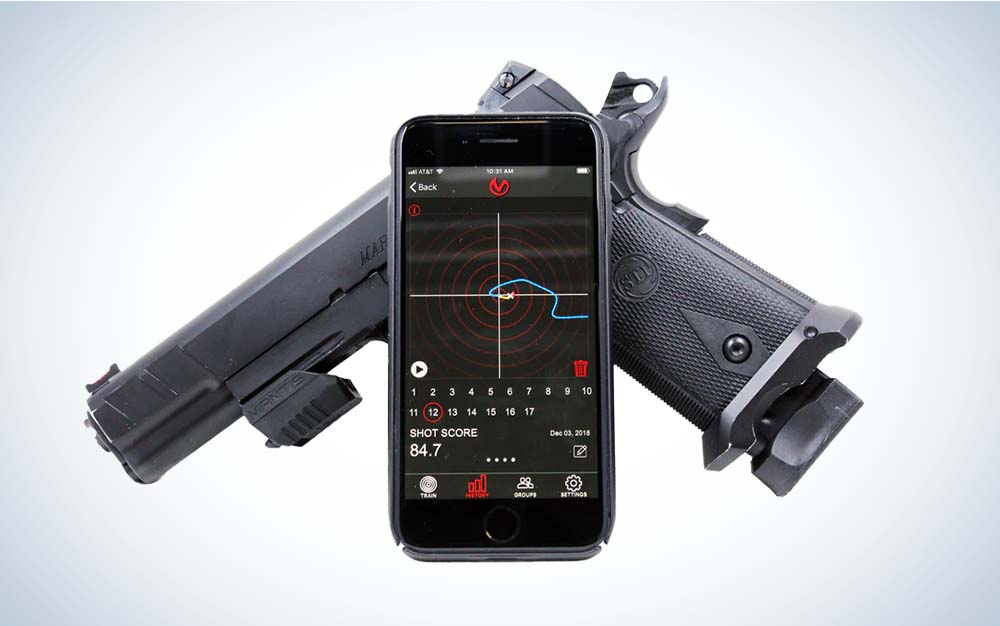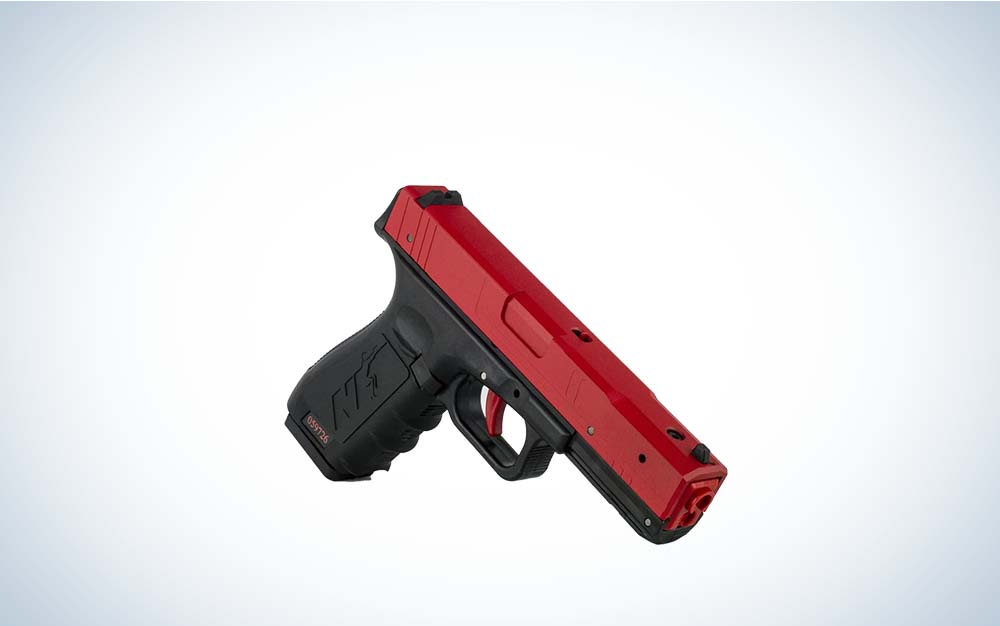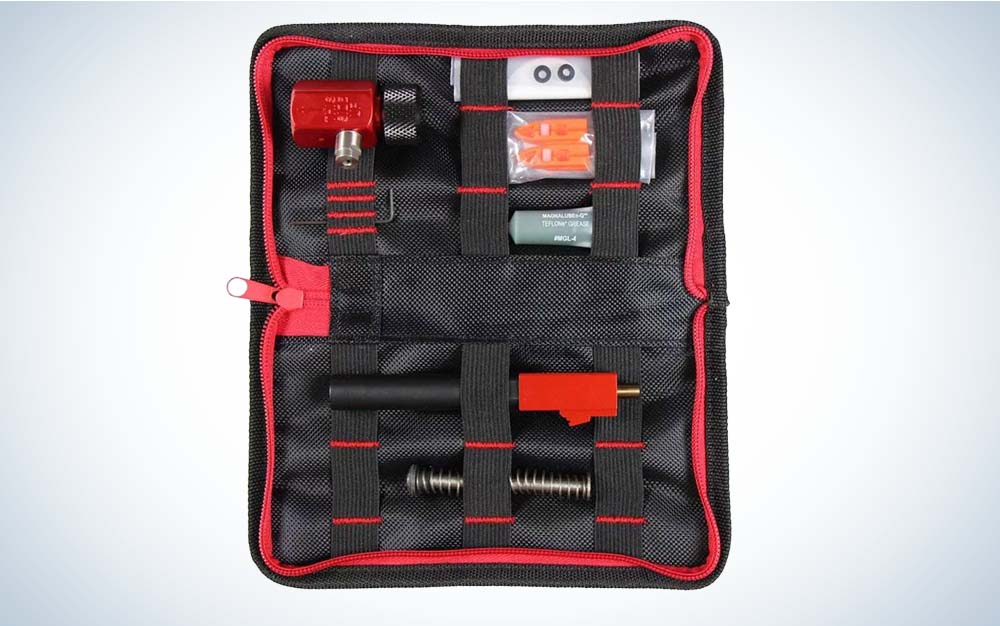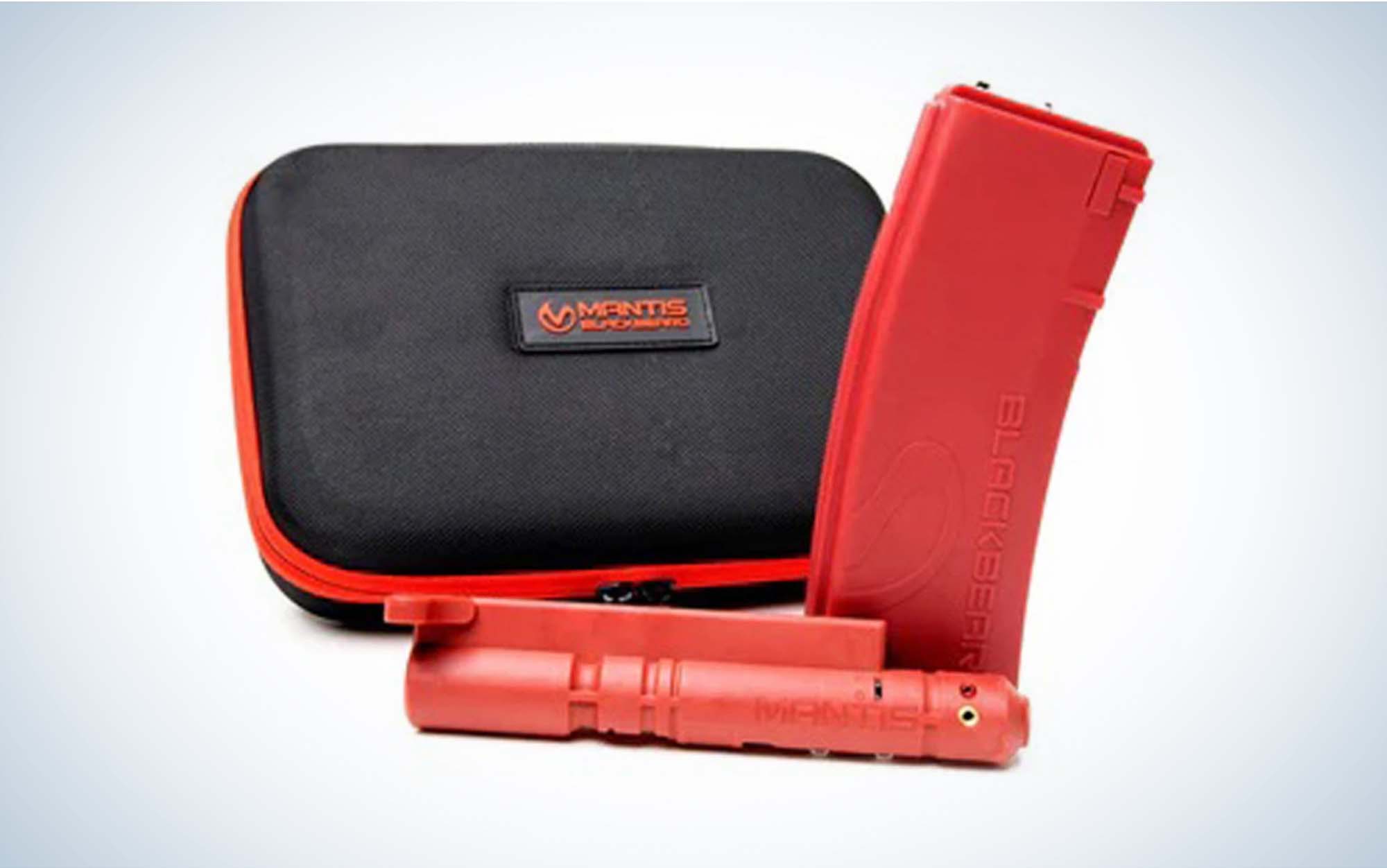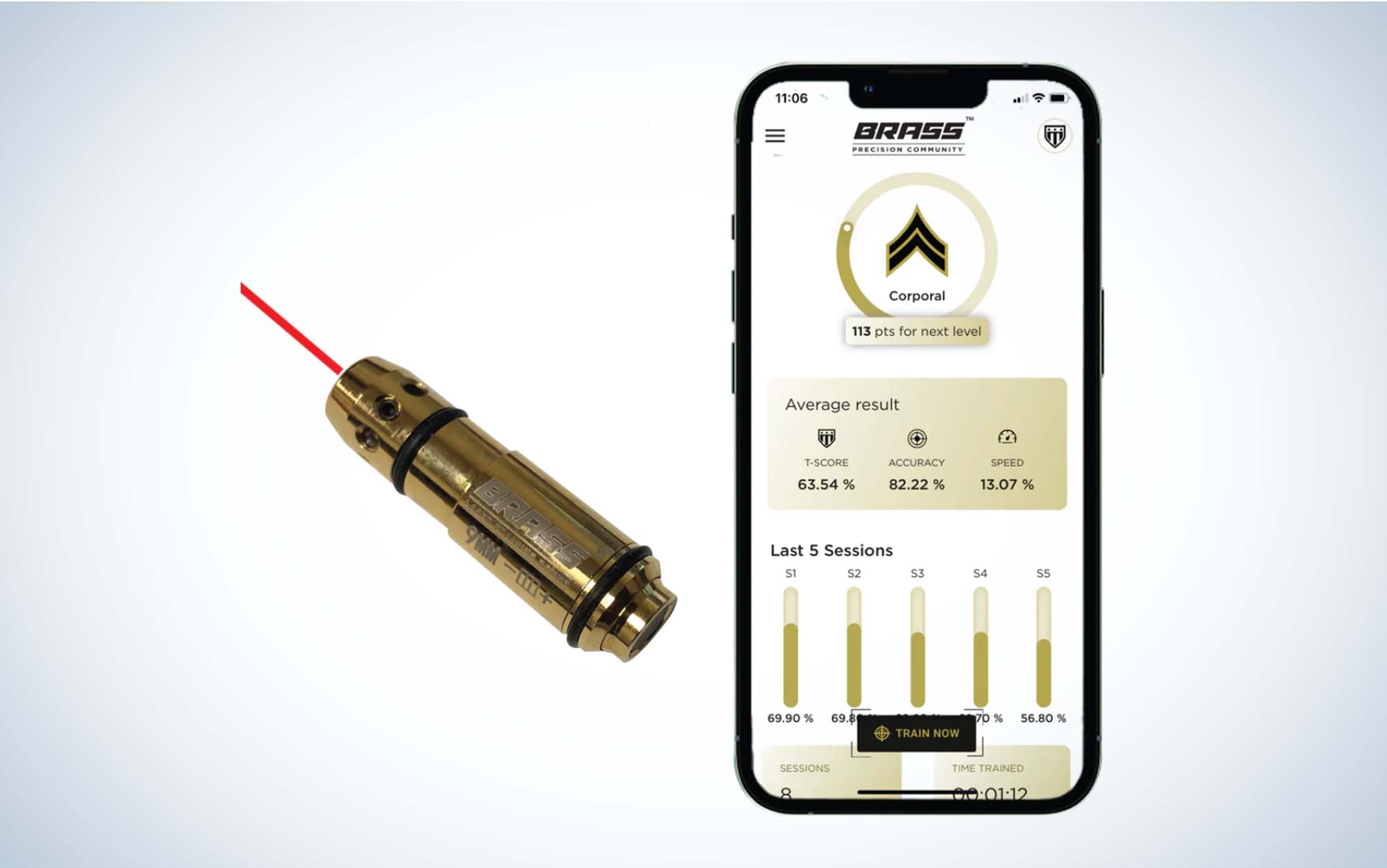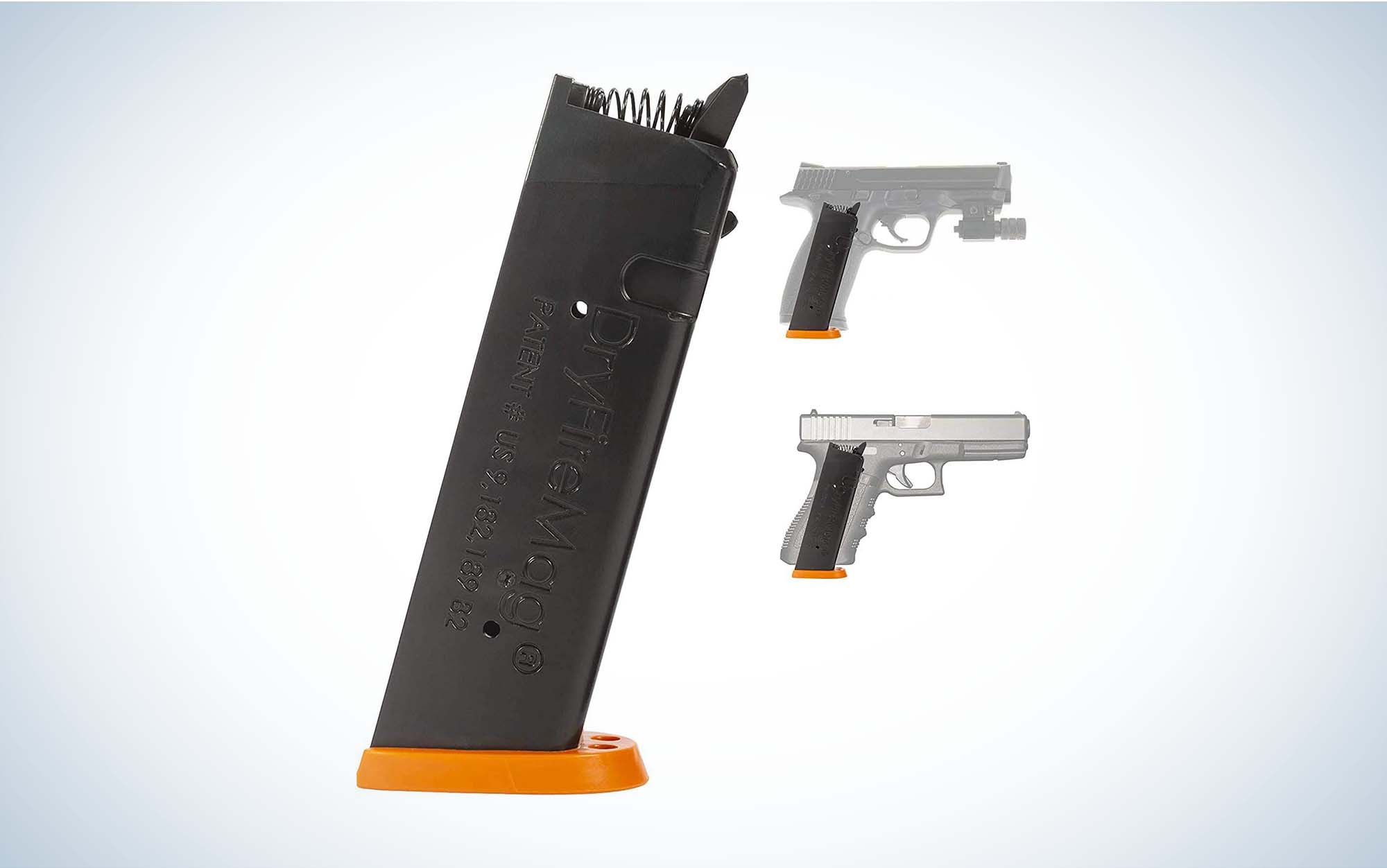The Best Dry Fire Training Systems of 2023
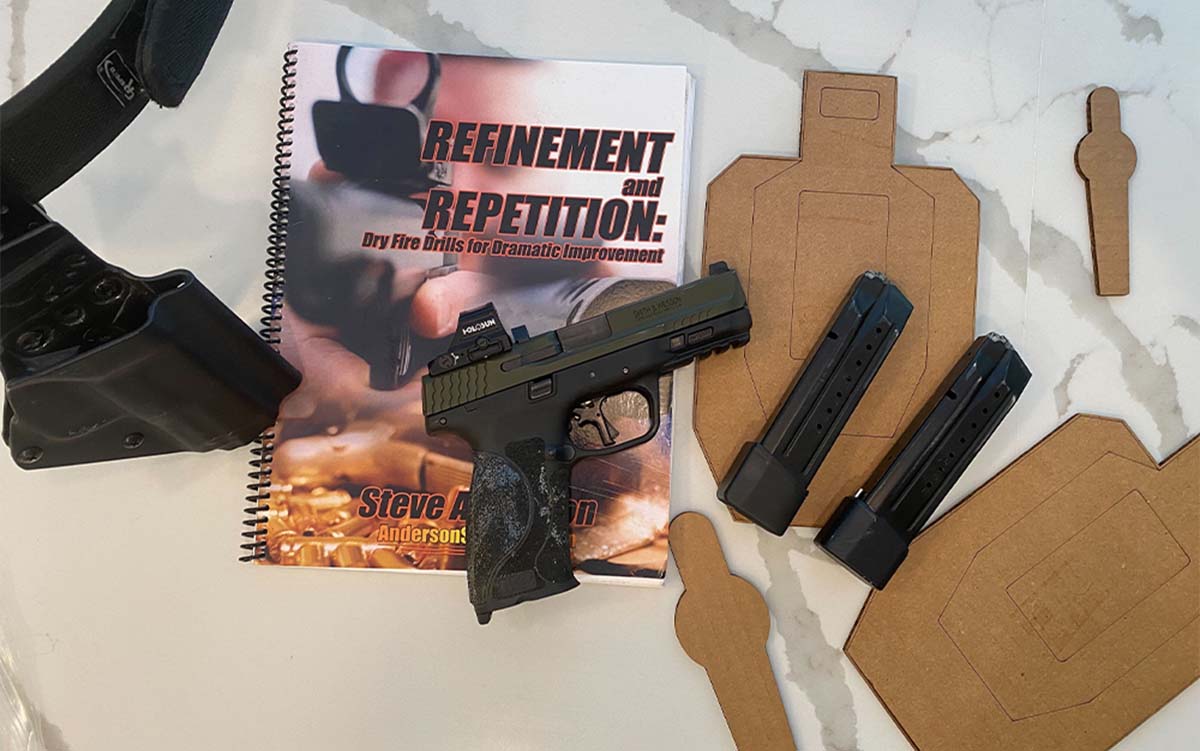
We may earn revenue from the products available on this page and participate in affiliate programs. Learn More ›
| Best for AR-15 | 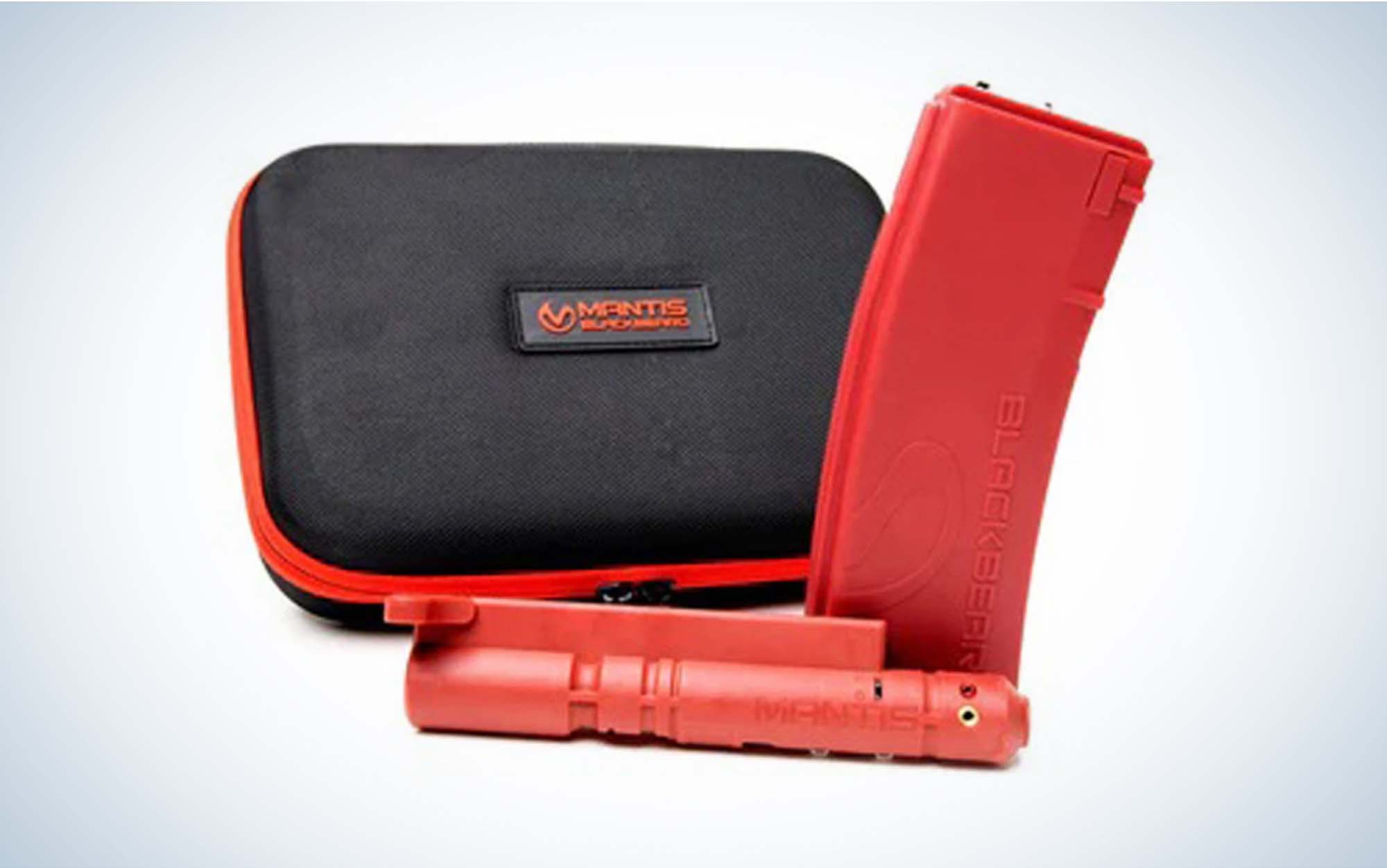 |
Mantis Blackbeard X | SEE IT |
LEARN MORE
|
Summary
Resets trigger on ARs and uses real-time feedback with Mantis and other laser-tracking apps |
| Best for New Shooters | 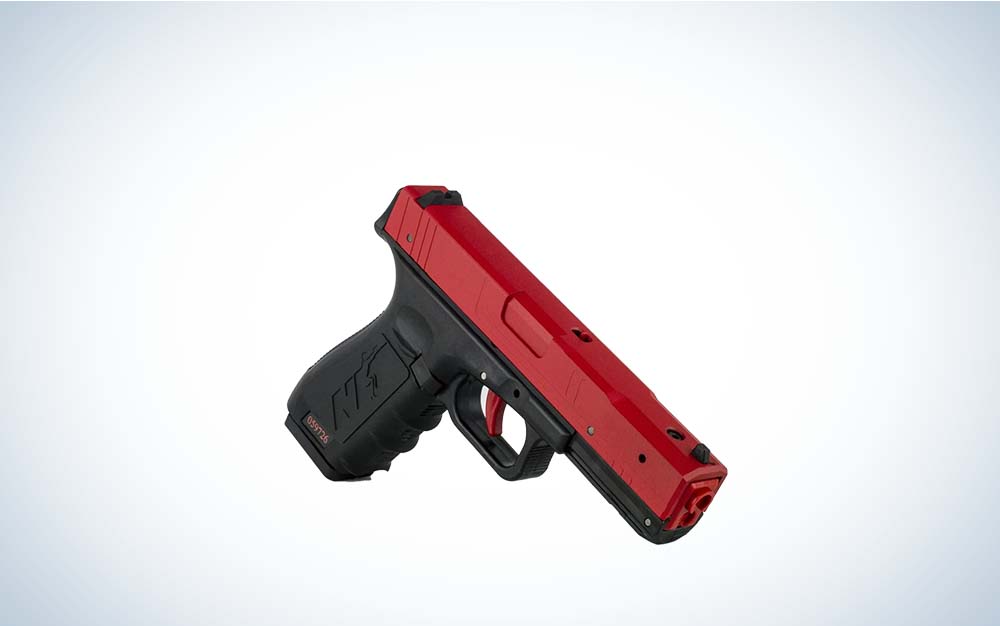 |
The SIRT | SEE IT |
LEARN MORE
|
Summary
A great way for new shooters to become acquainted with handguns. |
| Best for Simulating Recoil | 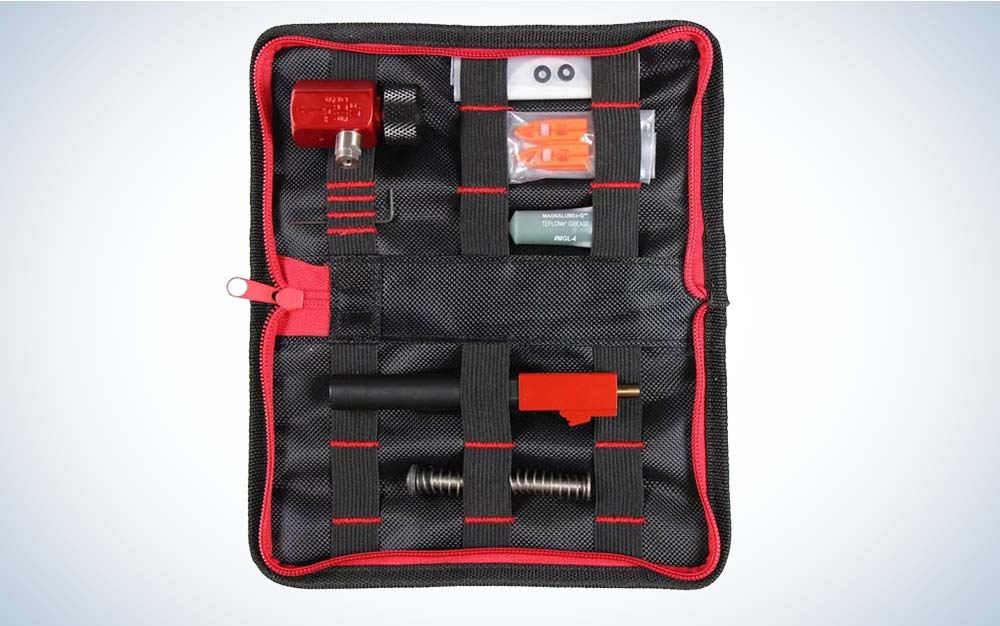 |
CoolFire Trainer | SEE IT |
LEARN MORE
|
Summary
Provides the recoil that’s usually missing from other dry fire systems. |
Dry fire training systems help with two elements needed to fire an accurate handgun shot: an acceptable sight picture and a trigger press that maintains an acceptable sight picture until the gun fires. This can be learned in live fire, but it’s easier learned and practiced in dry fire.
I’ve written several books on dry fire training and I’m a USPSA grand master, so dry fire is a large part of my life. I tested some of the best dry fire training systems to help you determine which is the best for you.
- Best for Improving Trigger Control: Mantis X
- Best Budget: Your Own Gun
- Best for New Shooters: The SIRT
- Best For Simulating Recoil: CoolFire Trainer
OL Staff Picks
- Best for an AR: Mantis Blackbeard X
- Triumph Systems Brass Beam and Brass App
- DryfireMag Dry Fire Magazine
- Best Book: Refinement and Repetition: Dry Fire Drills for Dramatic Improvement
How We Chose the Best Dry Fire Training Systems
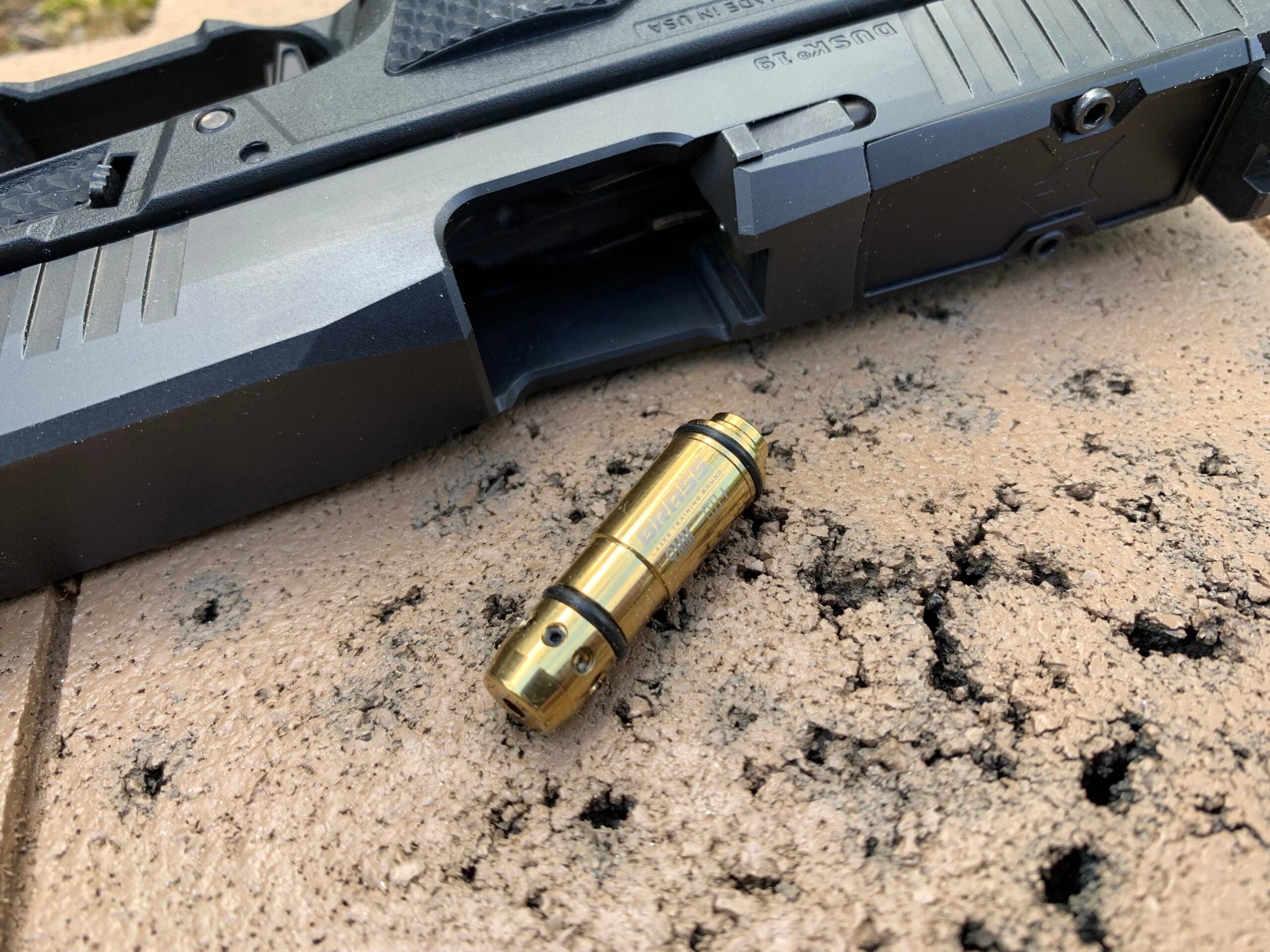
I evaluated these systems over the past few months while traveling to teach competition pistol classes. I also sought the opinions of other shooters of various skill levels to get different perspectives on these systems as well. I have been dry firing with my own guns for over 20 years and have written three books on shooting, including Refinement and Repetition: Dry Fire Drills For Dramatic Improvement.
The Outdoor Life staff picks were tested by staff writer, Tyler Freel, and gear editor, Scott Einsmann. They evaluated the dry fire tools separately from the author to provide additional product recommendations.
Best Dry Fire Training Devices: Reviews and Recommendations
Best for Improving Trigger Control: Mantis X
Mantis
Key Features
- Fits any firearm with a standard accessory rail
- Several different models with different functionality
- Connects to smartphone or other device
Pros
- Instant data about the quality of your trigger press
- Addictively fun
- Allows you to use your own gun and gear
Cons
- None
The Mantis X is a small square cube that attaches to the accessory rail of your handgun. A sensor inside it measures the quality of your trigger pull and reports the results to a smartphone or other device. Because I recently injured my trigger hand in an accident with a lawn mower, I enlisted the help of my good friend Pieter Smith to look at the Mantis at his home in South Africa, as I had a day off between teaching classes for South African IPSC shooters.
Neither I or Pieter are particularly tech-savvy, and it only took us about six minutes to install the Mantis on his CZ Shadow 2. Setup was extremely easy, and we just followed the phone’s prompts to get the app connected to the gun. The Mantis app is extremely easy to navigate and understand.
The CZ Shadow 2 is a double action handgun, which means that the shooter must master two different trigger presses—the more difficult hammer down and easier hammer back. We used to the Mantis to train these two trigger pulls.
In the app, I started with the Open Practice mode. In this mode, the Mantis measures your ability to activate the trigger without disturbing the gun and reports your success rate to you on the screen of your phone or provides audio reporting so you don’t have to look at the screen. Pieter is a top IPSC shooter in South Africa, so he was keen to find out how well he could score as the Mantis judged his performance. The Mantis made helpful suggestions on the screen anytime Pieter’s score dropped below a certain point, and all of this allowed him to identify the difference between a good or great trigger press with the immediate feedback of the app.
After this we used the Cadence Drills setting, which ask you to press the trigger more quickly, with your choice of 2 seconds, 1 second, or half a second in between shots.
Pieter began on a close target on his patio and had great fun seeing how his perceived performance measured up against the judgment of the Mantis. When he got it right, he reinforced what he did well. When his trigger pull needed an adjustment, he made the change, and the Mantis confirmed the improvement.
Next, I selected the Mantis Benchmark mode. This mode requires you to fire 10 shots with no time component. This lack of a time component means that Pieter had time to cock the hammer in between each shot to measure the quality of his trigger press in the gun’s single action mode. The single best trigger press he did was a 99.4, and I have no doubt he would have been able to get to 100. The Mantis keeps track of every shot in the app, and you can see your average for each session and for the entire day.
Best Budget: Your Own Gun
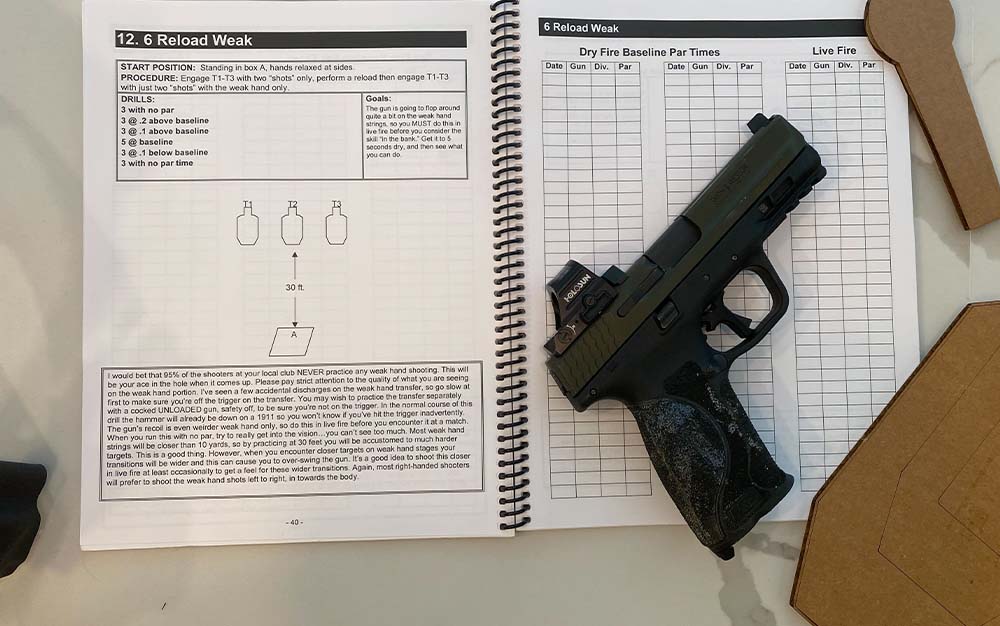
Key Features
- Nothing to buy except a shot timer
- Your gun becomes an extension of your body
- You gain massive amounts of subconscious skill
Pros
- You’re already familiar with it
- It’s the same equipment you’ll be using in competition or self-defense
- Develops performance under stress
- Budget friendly
Cons
- Requires you to handle a firearm in your home
- Semi-auto triggers will not reset when dry firing multiple shots
The best thing about the gun you already own is that you already own it. You don’t need to buy anything except a shot timer, or you can use a smartphone shot timer app. You will also need some dummy rounds and/or snap caps. The dummy rounds are inert cartridges that simulate the weight of real ammo, and snap caps may protect the firing pin of your gun if that’s a concern. Most centerfire guns will not be damaged by dry fire with an empty chamber, but many rimfire guns can be damaged by dry fire without snap caps.
Whichever timer you use must have a par time function. This is a second tone that occurs after the start tone to tell you how much time has passed since the start tone and is the easiest way to use a shot timer in dry fire. Once you can fire an accurate shot, you need to figure out what you need to do quicker, and many of these things don’t require you to fire a shot.
Anything that you need to do with a handgun can be improved by using par times. If you need a quicker draw, set your par time at two seconds, and see if you can complete the draw before the par tone sounds. If you can do that, reduce the par time and see if you can do that. If you can’t, look at every motion you are performing, and see if you can do anything sooner and/or faster. How long does it take you to reload your gun after it goes to slide lock? Would you like to be able to do it faster? Dry firing that skill with a par time will absolutely make you quicker, and repetition will make that reload a subconscious skill. If you need a quick reload in competition or self-defense, it should be subconscious act.
Dry fire practice with your own gun is a cheap, easy way to get better and faster. The gun becomes an extension of your body, and all these better, faster skills can be used under stress without active thought. Things like draws, aiming, reloads, and transitions between targets simply happen to the best of your ability if and/or when your conscious mind is thinking about something else, such as, sight picture or a potential threat. However, improving these gun handling skills is only useful after you can fire acceptable shots on demand. Until that happens, you might need a little more help with accuracy.
Best for New Shooters: The SIRT
NextLevel Training
Key Features
- Available in the shape of many popular handguns
- Provides a realistic reset of the trigger
- Allows instant laser confirmation of “hits”
Pros
- No risk of accidental discharge
- May be used where an actual firearm is prohibited
- Great for force-on-force training
Cons
- Requires shooter to look at target to confirm hits
The SIRT pistol is not a gun and is not capable of firing ammunition. It mimics the shape and basic function of the best handguns and has a self-resetting trigger. This is important because the gun you own is not capable of truly realistic multiple shot trigger pulls unless it’s a revolver. With virtually all semi-auto handguns, only the first trigger pull is realistic in dry fire because the slide only resets the trigger pull in recoil.
The SIRT features two lasers that are connected to the trigger. One laser shines when the trigger pull begins, and the second activates at the final press of the trigger. This is very useful for a novice shooter because you can see when you have touched the trigger, when the shot breaks, and where a bullet would have gone.
Another great thing about the SIRT is that it can be used for force-on-force training. You can simulate a defensive environment and know immediately whether a “shot” hit your assailant. I would never participate in a training session that allowed a real handgun to be pointed at a human being, but I would have no problem training with a SIRT against other people in a safe environment with no actual firearms in the room.
The SIRT is also useful in a home where the entire family has access to a defensive handgun. The whole family needs to be able to use the gun competently but may not be interested in the extensive study of shooting. The SIRT allows them to practice everything needed for self-defense in the home without ever leaving the house and address questions like: Where is the gun? How long does it take to get to it? Do I have an acceptable grip? Can I operate the trigger under stress without disturbing the sight picture? Do I have the will to point a firearm at another human in self-defense? It can also be used to get a new concealed carrier accustomed to carrying a gun, as well as putting that gun into action from wherever you carry it.
My only issue with the SIRT is that you need to look away from the sight picture to determine the location of the hit, which isn’t ideal in the higher levels of shooting and competition. However, for developing shooters, the SIRT is a great tool and the only tool I know of that can be used for completely safe training around other humans in any environment.
Best for Simulating Recoil: CoolFire Trainer
CoolFire Trainer
Key Features
- Available for use with many popular handguns
- Uses CO2 to cycle the slide and reset the trigger
- Provides a “semi-automatic” dry fire experience
Pros
- Simulates recoil with your own gun
- Helpful for learning to manage recoil
- Resets the trigger of semi-auto pistols
Cons
- More expensive than other systems
- Recoil is not identical to live fire
- Requires frequent recharging
- Slide velocity changes with CO2 level
The CoolFire system is one of few dry fire aids that simulates recoil with your own gun. It does this by replacing your gun’s barrel with one that is charged with CO2. The hammer or striker of your gun strikes a valve on the CoolFire barrel, and the compressed air causes the slide to cycle which provides a recoil effect and resets the trigger of your semi-automatic pistol. This provides a simulation of recoil and allows more realistic multiple shots in dry fire.
I tested the CoolFire with a Glock 34 equipped with a red dot sight. Installation for the CoolFire barrel and recoil spring was quick, as was charging the barrel with CO2 gas. The system includes a plastic spacer that is placed in the pistol magazine on top of live rounds or dummy ammunition that allows the slide to cycle without interfering with the ammo or snap caps in the magazine. A handgun is not capable of firing live ammo with the CoolFire system installed, but I would still recommend using dummy rounds or snap caps to provide realistic weight in the magazine.
The recoil provided by the CoolFire is about as powerful as live fire recoil and may be slightly more violent the lighter handloads frequently used in the “minor” power factor divisions of USPSA and other practical pistol sports. I fired 12 rapid shots with the Glock, and it felt fairly realistic. While the CoolFire recoil feels like live fire recoil, it doesn’t look the same. The red dot on the Glock 34 actually dipped below the aiming point in recoil instead of rising up like it does in live fire. This is not a problem for newer shooters but is not ideal for more experienced shooters who are learning to pay more attention to the sight picture during recoil as opposed to just before and after recoil.
With the CoolFire there is a sight picture, a disturbance in the sight picture as the gun recoils, and then another sight picture. This is good, but it’s not the same disturbance in the sight picture that happens when a live round is fired. I have worked with many clients who like to use the CoolFire at the end of a traditional dry fire session to remind themselves that the gun will recoil in live fire and to make sure their grip is appropriate.
If you want the gun to recoil in dry fire, the CoolFire is one of the best dry fire training systems for this purpose, and might be the only option if you want to use your own gun. It’s also the only way I know of to reset a semi-automatic handgun trigger during dry fire. It was necessary to recharge the CoolFire barrel with CO2 often, with faster trigger presses requiring more frequent charging. Another thing to note is that the recoil impulse changes as the CO2 becomes depleted. The slide begins to move slower as the gas runs out and eventually stops until the unit is charged again.
I would recommend the CoolFire to any shooter who needs to get accustomed to handling recoil, especially someone with limited access to live fire. They just need to understand that the sight picture will look different in recoil than it does in live fire. And I would absolutely recommend the CoolFire system to anyone who tends to flinch in anticipation of recoil, particularly a new shooter who may have an actual fear of recoil.
Best Dry Fire Training Systems: Outdoor Life Staff Picks
Best for an AR: Mantis Blackbeard X
Mantis
Key Features
- Auto-resets AR-15 triggers
- Laser feedback down bore with each trigger pull
- Bluetooth connection to Mantis X and Laser Academy Apps
- Drop-in function with your AR-15 rifle
- Price: $339
Pros
- Trigger reset allows multiple shot drills
- Compatible with other laser-feedback training apps
- Long battery life
- Uses your real rifle
Cons
- Expensive
- Can be difficult to index sights and laser at short ranges
Probably the best single dry fire training tool for AR-15 rifles is the Mantis Blackbeard X. It incorporates features of the Mantis Blackbeard, but adds bluetooth connectivity to the Mantis X and Laser Academy apps. It’s also compatible with the Triumph Systems Brass App reactive training app. Combined with the apps, the Blackbeard X gives you access to some incredible training tools and diagnostics.
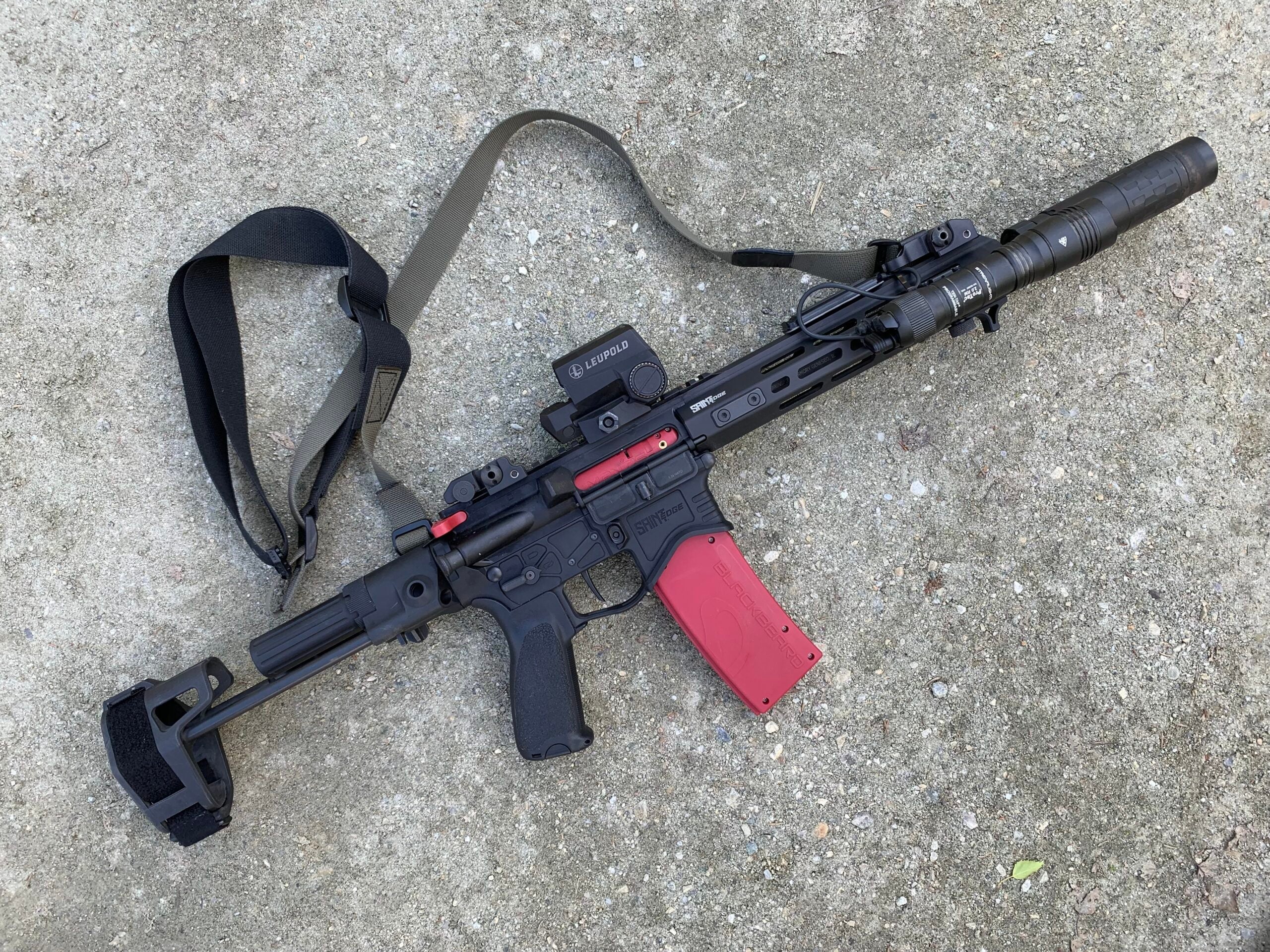
The Blackbeard X has two components, the laser and trigger-resetting mechanism, and the battery/bluetooth device. The first is housed in a molded assembly that replaces your bolt carrier group and charging handle. The second replaces the magazine. When both are installed, you can pull the trigger of your rifle, which will momentarily activate a laser that’s pointing down the bore. The laser can be adjusted to align with your sights, but because most AR sights and optics are high above the bore axis, the laser will usually impact below your sight radius at short ranges. When you fire, the device also re-cocks the hammer of your AR, resetting the trigger and allowing you to shoot again. This is a great feature for multi-shot drills, and improving target transitions and splits. —Tyler Freel
Triumph Systems Brass Beam and Brass App
Brass Beam
Key Features
- Firing-pin-activated laser cartridge
- Available in 9mm currently
- Fits into chamber of any 9mm
- Designed to use in conjunction with Brass App
- App doesn’t need specialized targets
- Price: $60
Pros
- Accurate feedback from dry fire training
- App and laser can track timing and accuracy
- App is compatible with other lasers like the Mantis Blackbeard
- You use your own pistol, or a laser trainer like the SIRT
- App is easy to use and doesn’t require specific targets
Cons
- This device doesn’t reset your trigger
Dry fire training is even more effective when you can get instant feedback, and the Brass Beam and Brass App from Triumph Systems work in conjunction to provide just that. The Brass Beam device is a firing-pin-activated laser that fits into the chamber of your 9mm pistol. When you pull the trigger, the firing pin momentarily activates a pressure switch that projects a laser onto the target. When coupled with Triumph’s new Brass App, it gives you instant feedback on time and accuracy. The only downside of the brass beam device is that it does require manually re-cocking the gun between shots, so it’s most strongly suited for quick-draw dry fire drills.
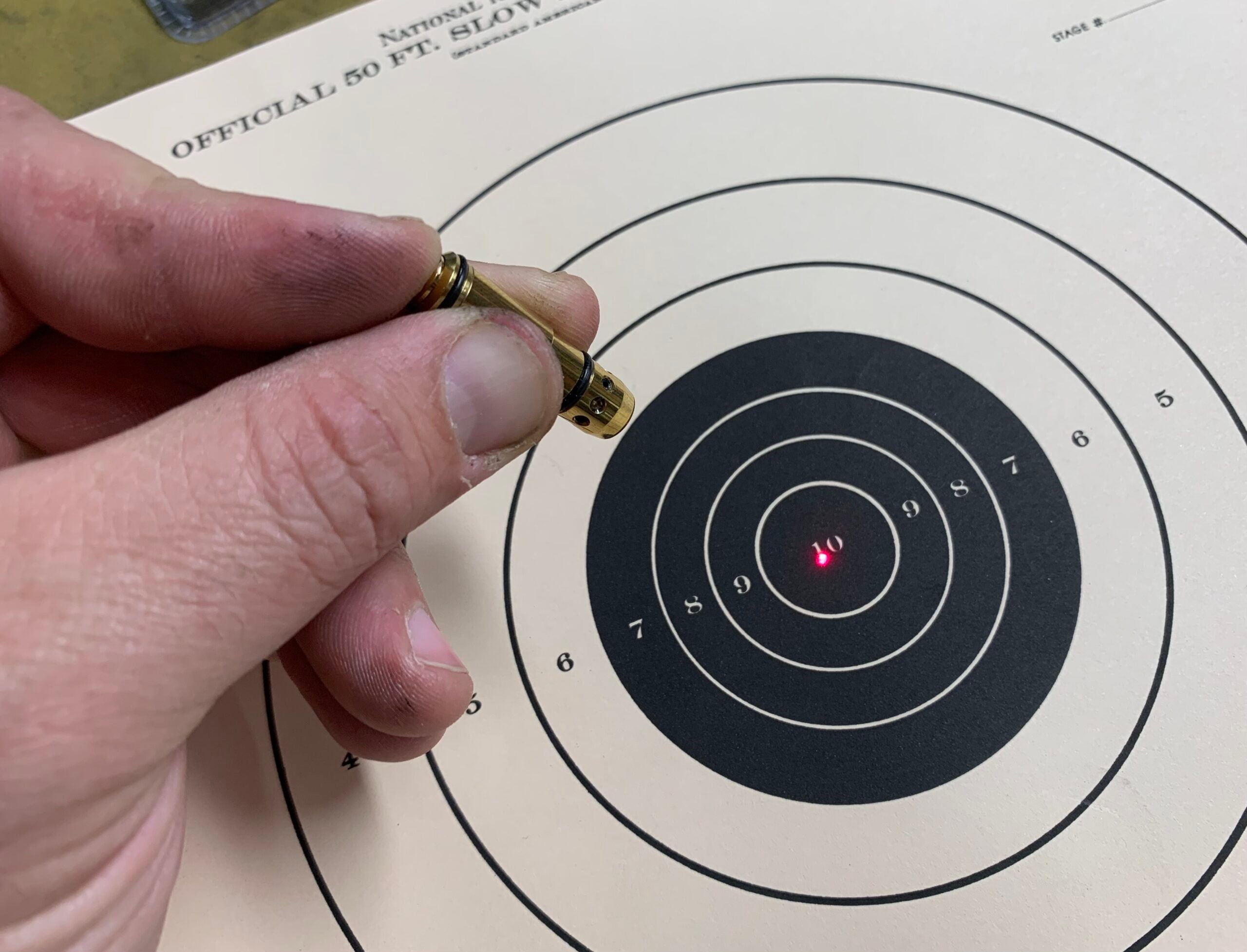
The Brass App is a reactive app for your phone that runs and times the drills, and the camera records accuracy from each laser shot. You’ll set your phone up on a tripod, with the camera pointed at your dry fire target array. Unlike some other apps, this one doesn’t require any specialized or color-specific targets, and it’s compatible with any laser dry firing device. Its target library features Triumph Systems round bullseye targets, but you can set up arrays using any round bullseye targets and calibrate the app for them. There are many different drills you can run with the app, and each has its own instructional video. Additionally, you can remotely restart a drill after running it by simply firing your laser onto the target again. —Tyler Freel
DryFireMag Dry Fire Magazine
DryFireMag
Key Features
- Dry fire Device replaces specific pistol magazines
- Device resets trigger, allowing multiple dry fire trigger pulls
- Springs are adjustable for realistic trigger weight
- Available for a variety of pistols
- Price: $99
Pros
- Allows multiple-shot dry fire drills with your pistol
- Audible and tactile trigger pull
- Simple and durable
- Great for in-home training without fancy equipment
Cons
- Doesn’t reset striker each shot, so it won’t give multiple shots with devices like Brass Beam
Aside from the lack of recoil, the only real drag about dry fire practice has been the need to re-cock your firearm between shots. It was never practical to do multi-shot dry fire drills or transitions because you had to stop and re-cock after each trigger pull. DryFireMag is a device that replaces the magazine of your pistol and it replicates a trigger pull and reset, allowing you to practice dry firing multiple times and expanding what drills you can do.

The DryFireMag doesn’t actually reset your trigger, and won’t activate the striker with each pull of the trigger. The design is slightly different for different handgun models, but they essentially use a spring-loaded paddle that presses against moving internal parts of the trigger. When the trigger is pressed, it pushes the paddle beyond a “click,” then releasing the trigger allows the device to reset. Differently weighted springs are available for some of the DryFireMags to tweak your felt trigger pull weight and mimic what you feel when you’re shooting for real. The DryFireMag is a simple device that can easily stow in your range bag and allows dry fire practice just about anywhere. —Tyler Freel
Best Book: Refinement and Repetition: Dry Fire Drills for Dramatic Improvement
Steve Anderson
Key Features
- 38 Dry Fire Drills
- Spiral Bound
- Pages for notes and recording times
Pros
- Easy to follow drills
- Has helped many shooters achieve their goals
Cons
- You will need dummy rounds and a shot timer in addition to the book
I have to drive an hour to a range I can shoot and move or practice any type of USPA drill. Add on my dwindling supply of pre-2020 ammo, and it’s obvious why I don’t live fire as much as I’d like. But, shooting is a perishable skill and to stay competent I rely on dry fire. But, if your dry fire practice is just ripping your gun from the holster as fast as you can and reloading as fast as you can, you’re not doing much to improve your skills. I know because that’s what I did for a year and it got me nowhere.
Refinement and Repetition was the missing key. It gave me goals and a roadmap to go from a barely C class shooter to someone that can hang with the B class shooters in a very short time. It’s not a book you read and then magically know how to shoot, but instead it’s a book that gives instructions for drills and speed benchmarks for those drills. Each drill is designed to improve the skills you’ll need for USPA stages, qualifier stages in particular.
To use the book, you’ll use a shot timer with the par timer setting. I use a shot timer app that I can connect to my wireless headphones so I’m not driving my wife and dogs crazy with constant beeping. Another key piece of gear are magazines loaded with dummy rounds, which keeps the weight and feel consistent. I have my practice mags marked and only have my practice mags in the room when I’m dry firing. Then I set up scaled dry fire targets per the drill instructions. The book offers guidance for setting the par time, and once you find your time through a little trial and error, you can start setting goals. You can also run the same drills during live fire training, which bridges the gap between practicing at home and match prep. —Scott Einsmann
Things To Consider When Buying A Dry Fire Training System
In the beginning, the problem with accuracy is usually a trigger pull that disturbs the sight picture. As a shooter gets better, the issue is more likely to be that the shot has been fired without an acceptable sight picture. These are both easy fixes if you know which problem you need to solve. A poor shot can always be corrected by a better sight picture or a less disruptive trigger press. Grip can be a factor, but only to the extent that it contributes to either of our primary components. Regardless of grip, a good sight picture and a good trigger press will always produce a good shot. A better grip simply makes the trigger more forgiving, in that a less precise trigger press is less likely to disturb the sight picture as the gun fires.
It’s crucial to understand that the quality of the shot is dictated by the quality of sight and trigger as the gun fires. Many shooters think that the shot goes where you aim when you decide to press the trigger. This is only true if the trigger press doesn’t disturb the sight picture. If anything happens as you press the trigger to disturb the alignment of the sights, the shot will follow the direction of the disturbance. This can be very frustrating because you might clearly see the target prior to firing a shot. However, what you didn’t see was the movement of the gun as it fired. Ideally, you’ll be able to see this yourself. But until you learn to do this, you may benefit from a little help, and that’s where the best dry fire training systems can help.
If you’re wanting improve your accuracy or become more comfortable with your own gun, here’s a few things to consider if you’re wondering whether or not you need a dry fire training system to help you in these areas.
Cost
Compare the cost of live fire with a dry fire training system. Dry fire might initially cost more, but live fire has always been expensive and seems to be getting more expensive all the time, especially with the current ammo shortage. It’s nothing to run through a couple boxes at the range. A few more trips, and you’ve already spent as much as you would on most dry fire systems. There is also the time and expense of getting to range to consider when you evaluate the cost of any dry fire system.
Goals
What are you seeking to Improve with your shooting? When choosing a dry fire system, you’ll need to ask yourself what you’re getting that you can’t do with your own gun. Most of these systems all do something that your own gun cannot do in dry fire, and you’ll need to determine which of these is most beneficial to you.
FAQs
Q: Is dry fire worth it?
Yes, dry fire is the cheapest, easiest way to get better at shooting very quickly.
Q: What is the best dry fire system?
Because there are different goals and purposes that you can address with dry fire, every system is better suited for some training purposes than others. Your own gun and a timer is the best way to get started. But the other products in this review are the best for their intended purposes.
Q: Is dry fire harmful?
The only risk of traditional dry fire is expecting your live fire speed to be identical to your dry fire speed. This mainly applies to the time between shots, but live fire will always be a little slower than dry fire simply because of recoil. Mechanically, dry fire isn’t harmful for centerfire, but you can always use snap caps or dummy rounds if you’re concerned about it. Rimfire, however, can be harmful, so make sure to use snap caps if you’re training with a rimfire handgun.
Is the Mantis worth it?
If you are taking your dry fire training seriously, and want detailed feedback from that training it’s absolutely worth it. However, lots of great dry fire training can be done without it.
What is the dry fire rule?
As generally understood, the dry fire rule refers to the presence of live ammunition, and is intended to prevent a negligent discharge. You should never have any live ammunition in the gun, in any magazines you are practicing with, in the immediate area of your practice, and some say you shouldn’t even have live ammo in the same room. This is to prevent any chance of accidentally loading a live round into the chamber while you’re training.
Final Thoughts on Dry Fire Training Systems
These devices all offer unique ways to make dry fire more effective and potentially more realistically. None of them are strictly necessary because you can use the gun you already own to become better with it. But, if any of these devices inspire a shooter to practice more diligently and more often than traditional dry fire, I heartily endorse all of them for their intended purpose. They’re some of the best dry fire training systems, and they make dry fire more exciting and fun. And because many shooters think dry fire is boring, excitement and fun may be enough reasons to own any of them.
The post The Best Dry Fire Training Systems of 2023 appeared first on Outdoor Life.
Articles may contain affiliate links which enable us to share in the revenue of any purchases made.
Source: https://www.outdoorlife.com/gear/best-dry-fire-training-systems/
